Blogs
Dive Indonesia Part 2: Raja Ampat Trip Report
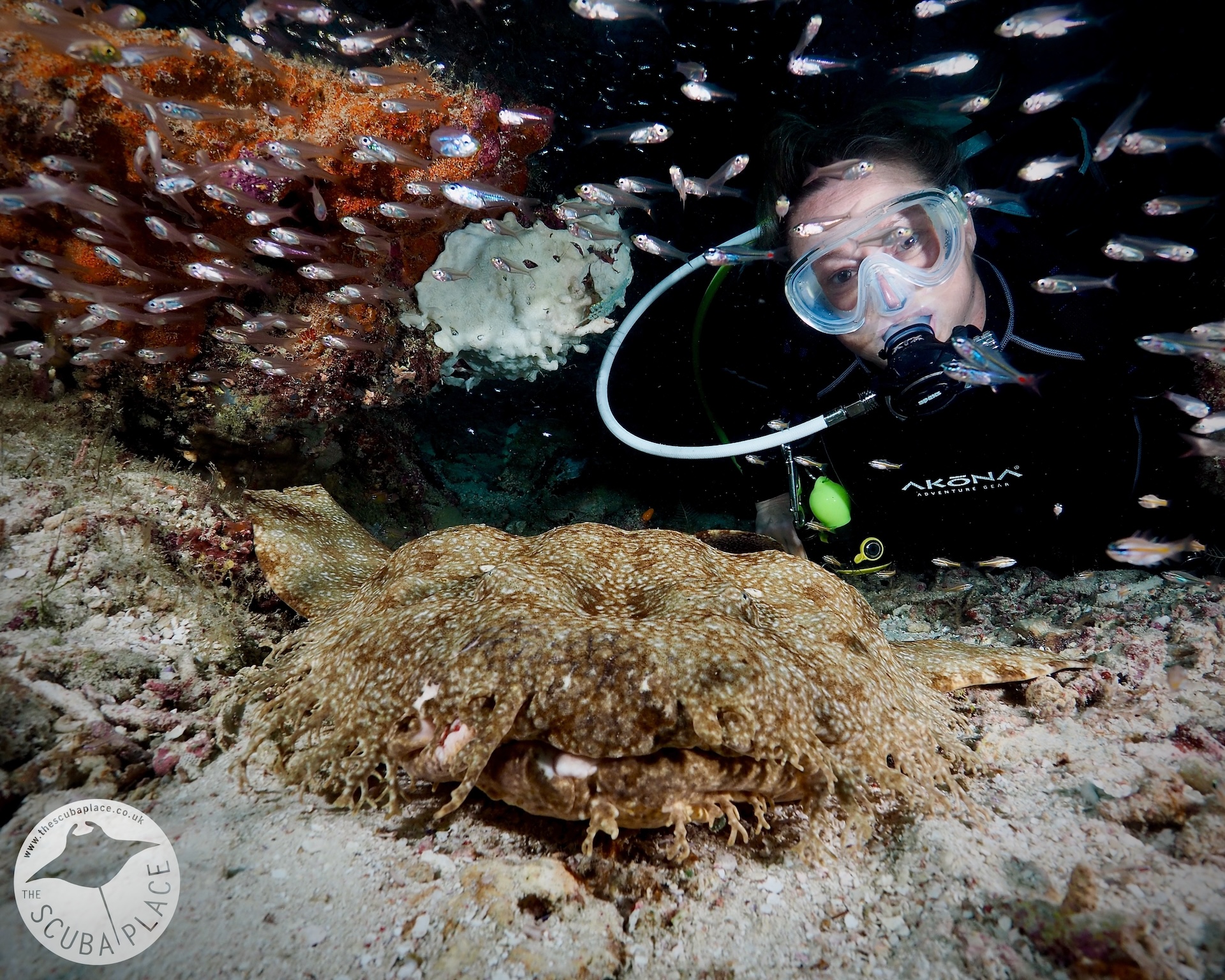
This January The Scuba Place visited Ambon, Raja Ampat and Lembeh hosting agroup of divers. They stayed at some amazing spots and saw some amazing things. This is their trip report on their second stop in Raja Ampat.
Raja Ampat has always been on our bucket list – just like pretty much every other diver on the planet! We just had to go, and so the choice of liveaboard or resort was the only difficult one we had to make! We chose the latter and opted to stay at the enticing Dive into Raja Ampat.
This was, for some of our group, our second week in Indonesia, and we flew into Sorong from Ambon. Our other guests flew into Jakarta the night before, and flew on to Sorong in the early hours, catching the early ferry to Raja. Landing in Sorong, after walking across the tarmac and collecting our bags, we piled ourselves into the waiting SUVs and made the 20-minute trip to the port to catch the inter-island ferry.
It’s hot, loud, humid, busy, and seemingly disorganised chaos, but it works – welcome to the islands of Indonesia! Our drivers, provided by the resort, arranged for porters to take all our bags onto the ferry. We were shepherded upstairs into the VIP Cabin where the air-conditioning was very welcome. We checked every bag was present and got ready to relax for the two-hour crossing to our island resort. These are big and fast ferries, and they are super-stable, so we weren’t troubled by any seasickness, and a simple range of snacks (biscuits, crisps, and a local version of a pot noodle) and cold soft drinks were available from a small café on board. It seemed as though time flew, and we arrived into the port of Waisai on Waigeo, Raja Ampat’s largest island.
Disembarking was again an experience, but the resort staff were there to collect us and our bags, popping us into waiting SUVs and whisking us off to the resort – a mere 15 minutes away through some stunning scenery.
We arrived and were greeted with a cold drink, and a cold flannel, and welcomed to the resort. Our bags were taken to our rooms whilst we sat and chilled for a bit, and after a shower and a change, we were given a resort and dive briefing.
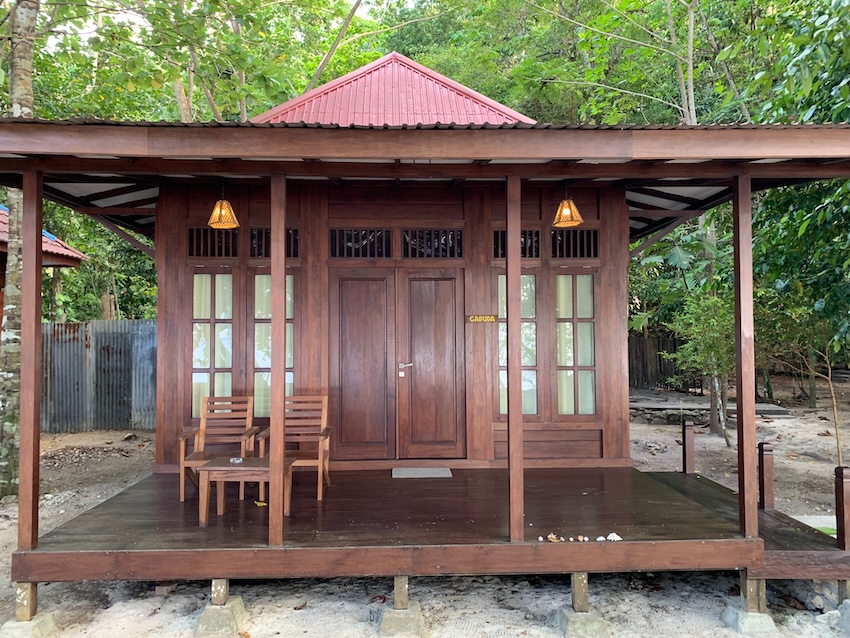
The resort, made up of 14 rooms, a restaurant, and the dive centre, sits underneath the jungle canopy and on a white sandy beach. There are three room categories – Garden terrace rooms, Seaview rooms, and Waterfront villas. The rooms are super comfortable, with effective air conditioning, vaulted ceilings with fans, a deck or terrace with furniture, en-suite shower rooms and an outdoor shower tap to rinse off. Each room also has its own water dispenser providing both hot and cold drinking water. The Seaview rooms and Waterfront villas have spectacular views, and the Garden terrace rooms have partial sea views too. More Waterfront villas are planned, and they really are on the waterfront – the sea comes right up the beach to the deck at high tide!
The restaurant offers water, tea, and coffee all day, and breakfast starts early for those who get up with the beautiful sunrises. Eggs and omelettes to order, plus fruit, cereals, toast, and a selection of hot offerings, both local and western, set you up well for the day. Lunch and dinner are again buffet style – a superb homemade soup, fresh slices of bread and then both Western and Indonesian main dishes, served with rice, noodles or potatoes. Fruit makes up the dessert at lunchtime, and a proper pud is offered at dinner. An afternoon snack is a welcome treat after the afternoon dive – expect cakes and pastries and all things non-diet related! Special dietary needs can be catered for if pre-advised.
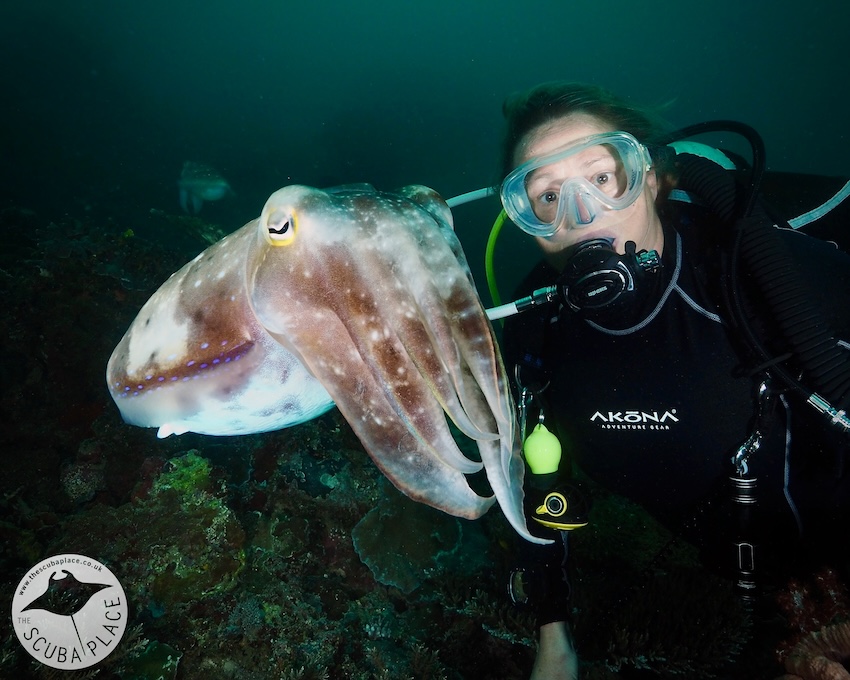
The bar sits right alongside the restaurant and faces the sea – a great place to grab an ice-cold beer, wine from the small but decent wine list or a cocktail We sampled a few of these, in the pursuit of accurate research of course, and they hit the spot!
The resort fringes the jungle canopy, and it is just beautiful. Look up, and there is green everywhere – and birds of paradise, butterflies, geckos, and the cuscus bear – a sloth-like member of the marsupial family that clambers with great dexterity and no haste in the trees around the resort. Ask any member of staff and they will point to one without hesitation – which will save craning your neck for ages while you look for them with untrained eyes!
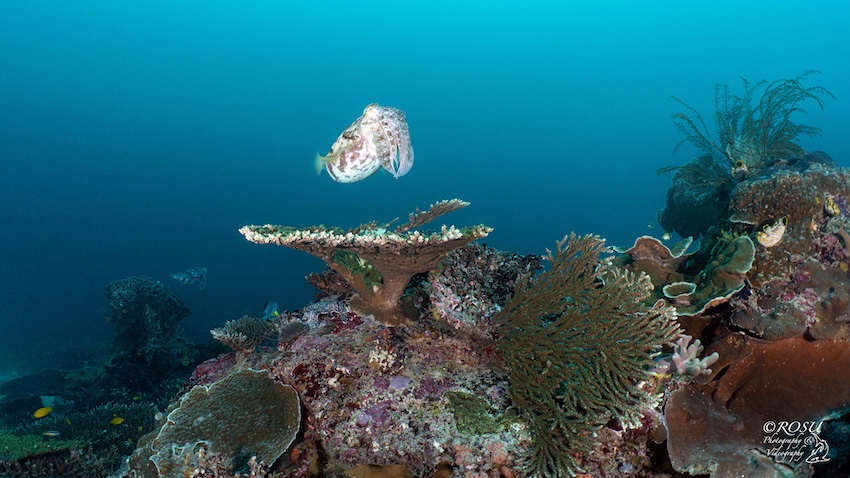
The dive centre is right on site, and the jetty to take you to the dive boats is a minute’s walk along the beachfront. The recently re-built dive centre has individual hanging spaces for each diver, rinse tanks behind and a superb camera room with separate rinse tanks, air guns and individual charging and assembly desks right next. Locked at night, the camera room opens at 6 am and closes at 10 pm, giving ample time to get in and organise yourselves! Nitrox, 15-litre tanks and even DPVs plus a whole range of equipment are available right on site.
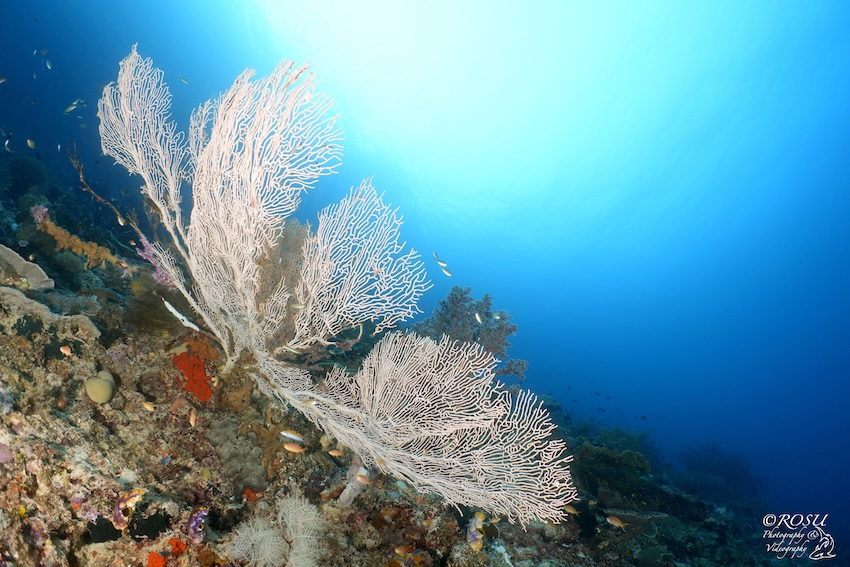
The normal dive day comprises of a two-tank boat trip in the morning and a single-tank boat trip in the afternoon. The house reef is open all day! There are a couple of longer day trips with three dives and lunch on board the dive boats, and these are not to be missed. We took a trip to the famous viewpoint at Piaynemo and the manta cleaning stations, for both oceanic and reef mantas and these excursions should be on every visitor’s dive plans.
And the diving? Huge – that is the only word that I can use to describe the underwater world in Raja Ampat. Huge corals. Huge schools of fish. Huge reefs. Huge list of marine life encountered. And huge currents from time to time too!
The resort is in the Dampier Strait, home to many of the dive sites on any Northern Raja safari itinerary, so we sped out to the best of the best dive sites each day. And a strait it is – a through route between islands that inevitably brings in currents and big tides moving nutrients through the waters, both of which are reasons why the reefs are so incredibly healthy
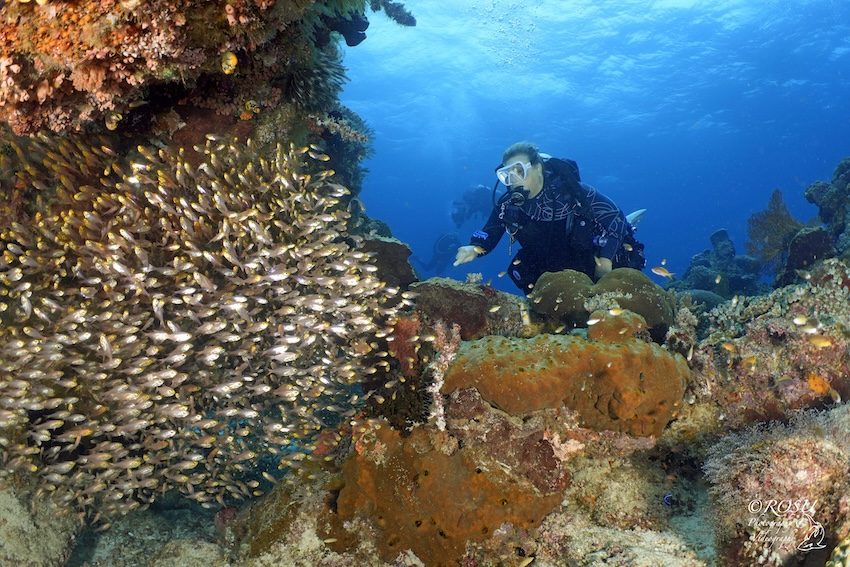
We saw mobula and eagle rays, barracuda, jacks, snapper, grunts, banner fish, batfish, tuna, billions of glassfish and sweepers, rainbow wrasse and so much more. Cuttlefish that were happy to interact, wobbegongs sleeping below overhangs, huge green and hawksbill turtles, octopus, signal gobies, and blennies galore. We found numerous types of clownfish in their multi-coloured anemones. Even some very very territorial ones who would defend their homes from about 5 metres away! Frogfish, ornate ghost pipefish, banded pipefish, porcelain crabs, squat lobsters – the list goes on and on – and then on some more!
Oh – and the manta rays! We saw both reef and oceanic mantas. And let’s not forget the sharks! Grey reef, black tip, and white tip reef sharks were seen on lots of our dives, and on some of the bigger current dives, we saw them in big numbers off the edge of the reef.
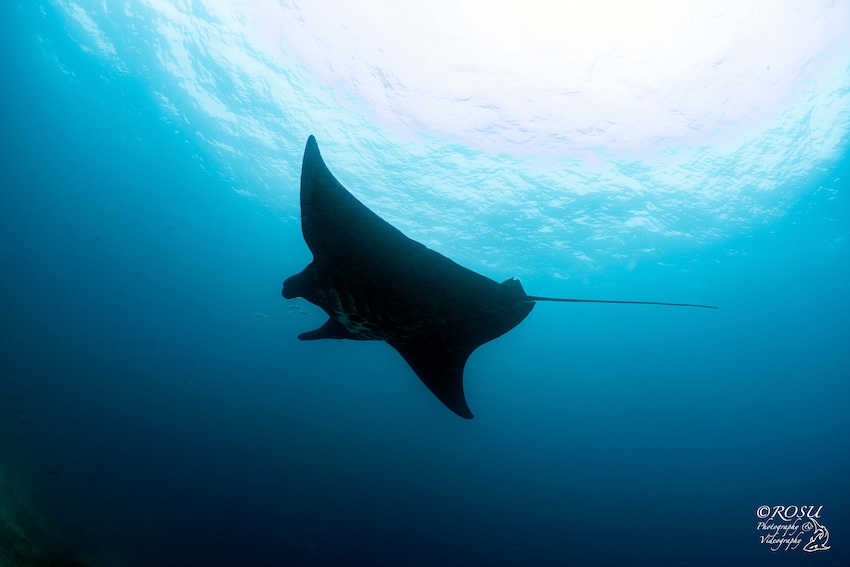
Special thanks to Rob and Susie for sharing some of their amazing photos from the trip.
Visibility varied from 20+m to less than 10m, depending on the dive site, current and tide, but whatever it was, there was loads to see. The corals are immense, and the reefs go on and on. Staghorn coral forests, gorgonian giants, whip coral jungles, stunning sponges everywhere – I have never experienced so much life underwater anywhere! The water temperature hovered around 29′ for every dive, but there were one or two thermoclines that brought on a shiver for a moment or two. Most of us wore 3mm full suits and didn’t have an issue maintaining core temperatures, and we did a lot of diving!
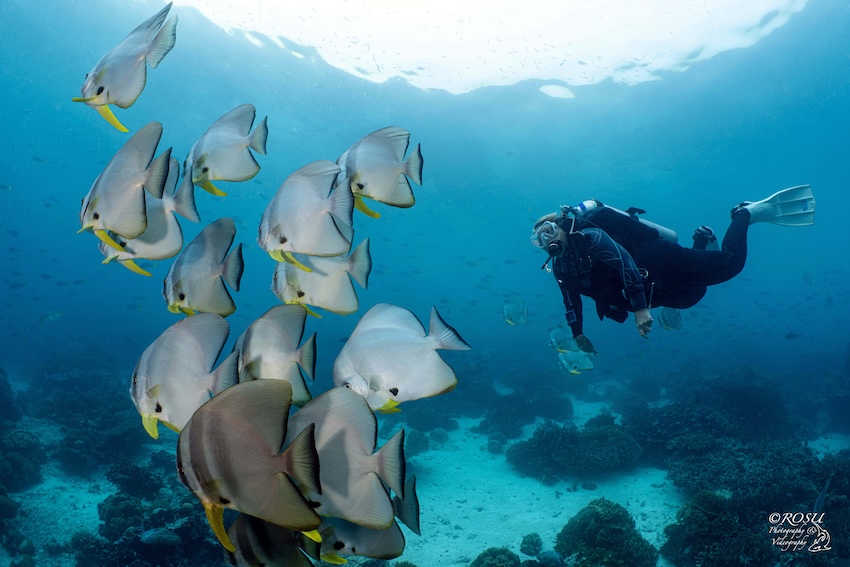
We did some gentle bimbles along the reef, some deliberate drift dives, and some hard-core dives into the current to get to points where the shark action was taking place, and we did a dive in the biggest current I have ever experienced! All the big drift dives previously experienced across the globe became like a kid’s slide in a soft play park compared to this one at Kri Island. We were simply grabbed by the current without any notice and launched at breakneck speed over the top of the reef, whipping past bommies and pillars, using our fins to steer between fans and a shiver of half a dozen reef sharks, we were eventually catapulted out into the blue at the end of the reef – what an experience!
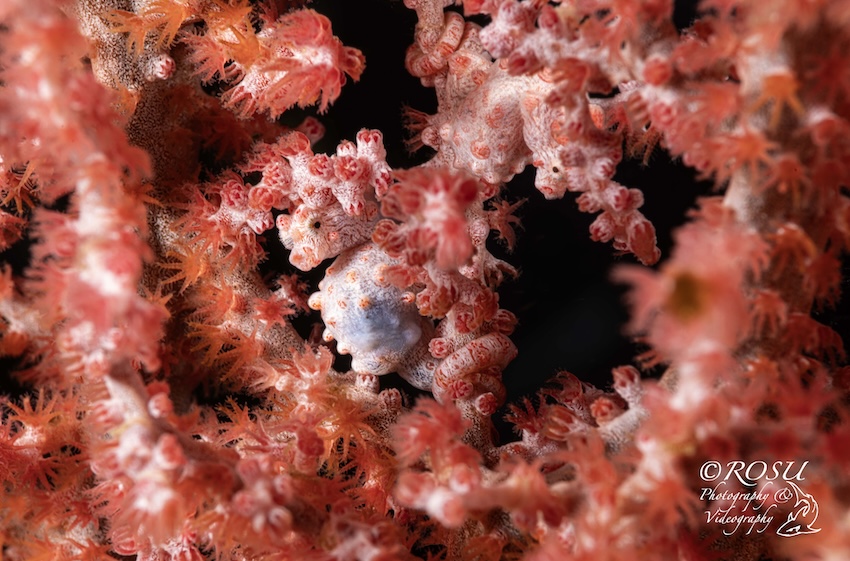
We did a couple of additional excursions in our week with Dive into Raja Ampat – a three-tank day trip to dive with the monitored populations of manta rays, and a three-tank day to take in the iconic views of Piaynemo.
The mantas are monitored by scientists, and there is an observation platform on top of the reefs where they visit a favourite cleaning station for the Oceanic mantas. Across the reef, we also dived on the lookout for reef mantas, and we had Lady Luck with us as they turned up! As we continued down the reef, a fever of at least 16 mobulas flew by in formation.
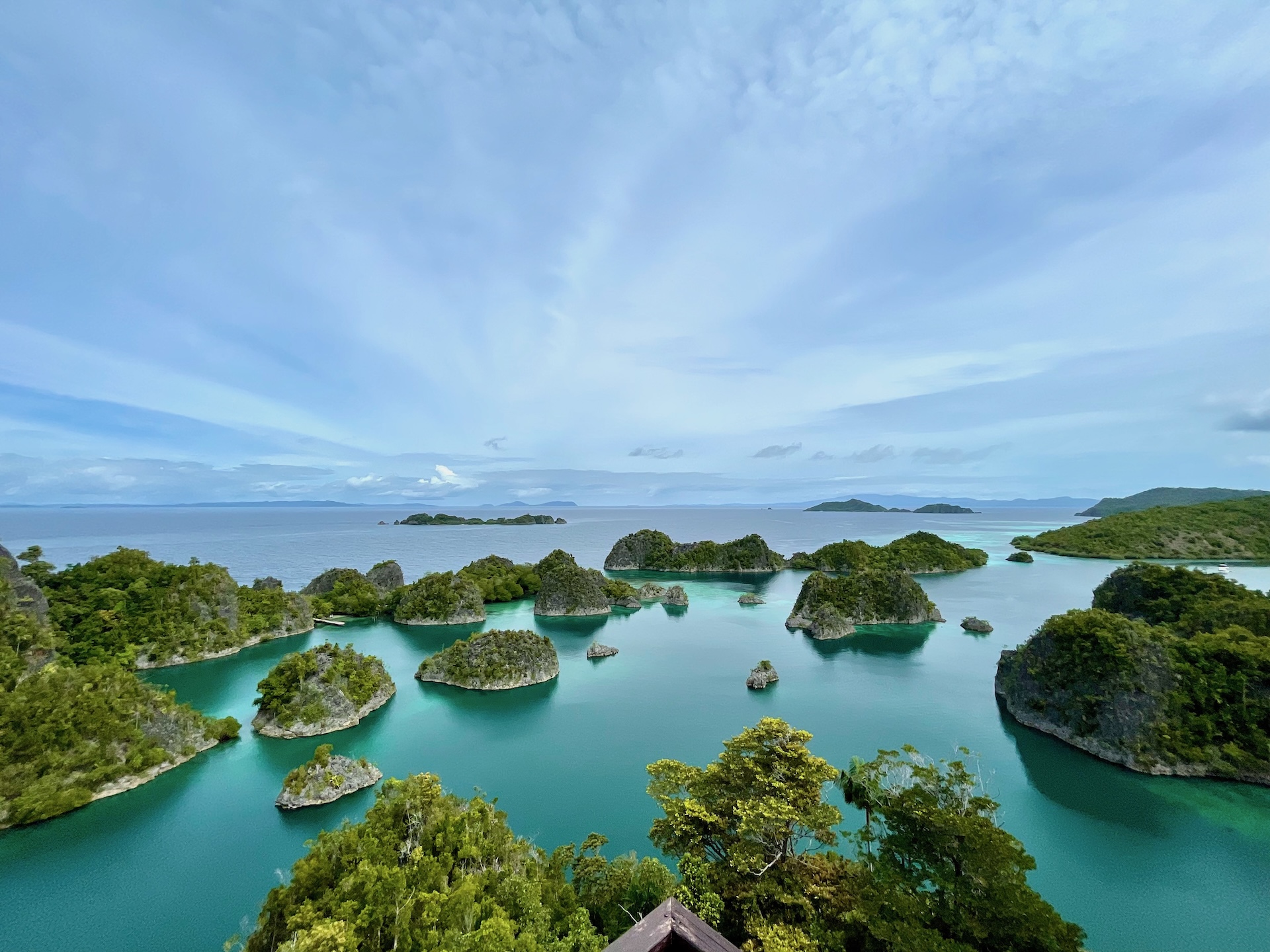
The trip to Piaynemo was great fun with two awesome dives, and then a big climb up the hill to the viewing platform. We had blue skies and captured that photo that is synonymous with being in Raja Ampat. A third dive on the way back home under a pier was excellent. It gave us a lovely backdrop for photography and was complete with turtles and curious batfish.
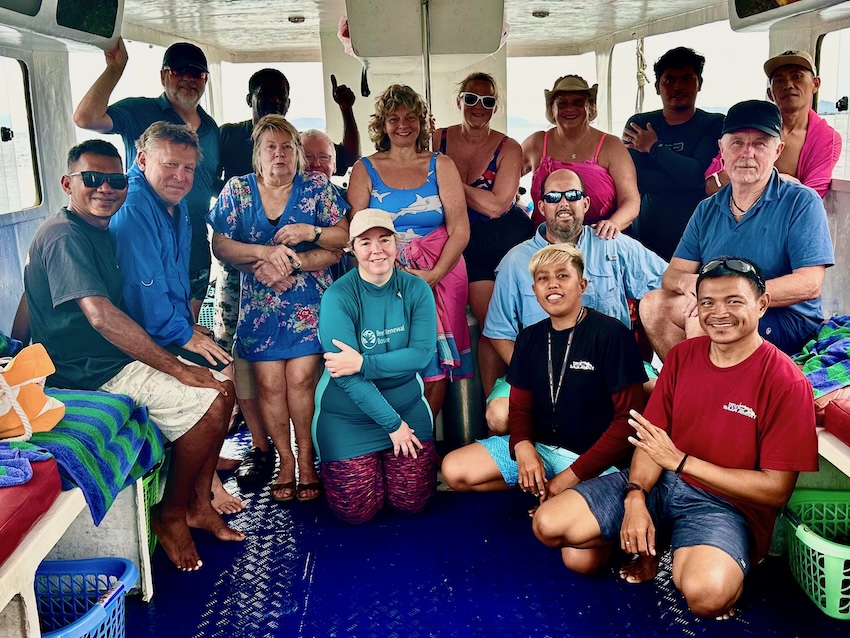
The dive staff were amazing for the whole week – they know their dive sites and found us all sorts, and they always kept an eye on us and ensured our safety. You can have thousands of dives in your logbook, but a different environment can be a real leveller, especially if there is a huge current or reduced visibility.
The dive boats are big, fast, and comfortable with a roof deck and an open bow area with seating if you wanted the sunshine, or a covered deck if you wanted to stay in the shade. A sea toilet on board made things easy and there was ample cold water, tea, and coffee, plus biscuits between dives! Backward rolls were our method of entry, and the ladder to get back into the boat was sturdy and easy, even for us with old bones and joints!
In one week, we dived most of the dive sites that a safari boat would do on the Northern Raja itinerary – we even tied up alongside one or two of them while our dive guides caught up with their friends on surface intervals! We love liveaboards, and there are some absolute stunners in Indonesia, but a week at Dive into Raja Ampat is exceptionally good value for money and considerably cheaper than a liveaboard, so we still can’t answer the opening question – Resort or Liveaboard?
We had a blast, loved the diving, loved the resort, and loved the whole experience – Raja delivered everything that we had anticipated, and more!
Key Facts:
- Getting there :We suggest flying with Emirates from Heathrow to Jakarta via Dubai. From Jakarta you can fly direct to Sorong on Garuda Indonesia. We prefer Garuda with their free 23kg dive equipment baggage policy and the flight is 4 hours. We were greeted at the airport and transported to the ferry port for our VIP crossing before a quick 15 minute transfer to the resort.
- Air temperature : Wageo in Raja Ampat enjoys a tropical rainforest climate – average daily temperature throughout the year is 29 to 31°C. The warmest and driest months are August and September and the wettest months are usually November and December
- Water temperature :An average of 30°C. A 1-3mm full suit or shorty will suit most.
- Visa requirement : We purchased our Visa on Arrival at the Jakarta airport for $35 USD (or 500,000 IDR) The visa is for an initial period of 30 days. Make sure you have pristine bank notes if paying in USD or exchange your GBP when you get to Indonesia. The bills must be unmarked and undamaged to be accepted. The Customs Declaration must be completed online and the provided QR code is shown to the Customs officers.
- Currency : Indonesian Rupiah(IDR) or US Dollar are accepted most places. We exchanged Sterling for Rupiah at the Jakarta airport for an attractive rate.
- Electricity :230V with European style (round pin) two-prong plugs. Our room and the camera room had extension leads with UK plugs so no adapter was needed.
- Internet and Wi-Fi : There is wifi in resort and worked well in our room. We were able to email, WhatsApp and post on social media without issue.
Price Guide: A week at Dive into Raja Ampat, including flights from the UK with baggage and transfers, on a 3 dive per day package including full board accommodation in a Garden terrace room, costs from £2599 per person, based on double occupancy. The bulk of the cost is the flights, so the cost of staying longer is surprisingly low! Extras: Indonesian Visa on Arrival, NITROX, soft drinks and adult beverages, and tips.
Our Advice: Indonesia is an amazing destination. Dive into Raja Ampat was the second top on our three-centre trip and the perfect stop for the big stuff in between our macro destinations of Ambon and Lembeh.
Packing tips :
- Rechargeable fan(s) :Perfect for warm planes, stuffy transfers and still evenings. We can’t believe we travelled without them for so many years! Join the fan club and grab one off Amazon… you won’t regret it!
- Travel laundry line : We find this comes in handy for any mid holiday hand washing and definitely at the end of the trip to hang SMBs, reels, dive socks etc.
- Insect repellent : We’ve made a habit of throwing some repellent in our dive bags every trip!
Sunscreen : Don’t forget to protect yourself when you’re in the sun and on the water!!
Come Dive with Us!
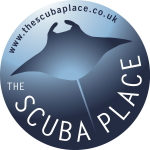 The Scuba Place designs and builds custom scuba diving holidays. With personal knowledge and experience diving in many of our destinations, there is no one better to help build your dream dive holiday. Come Dive with Us!
The Scuba Place designs and builds custom scuba diving holidays. With personal knowledge and experience diving in many of our destinations, there is no one better to help build your dream dive holiday. Come Dive with Us!
Call us at 020 3515 9955 or email at reservations@thescubaplace.co.uk
Find us at https://www.thescubaplace.co.uk
Facebook : https://www.facebook.com/thescubaplace
Instagram : https://www.instagram.com/the.scuba.place/
YouTube : https://www.youtube.com/channel/UCH684OdioYirI-zzdT58Ceg
Blogs
Magical Socorro: a Dream Diving Adventure

By Mark Murphy
Socorro, January 2025 with Oyster Diving
Picture this: giant manta rays gliding effortlessly, playful dolphins pirouetting around you, and a majestic whale shark stealing the spotlight. That’s exactly what awaited me and 14 fellow divers from Oyster Diving on our unforgettable journey to Socorro. It was a dream six years in the making, sparked by a recommendation from a seasoned diver I met in the Galapagos. His words echoed in my head: “If anywhere rivals the magic of the Galapagos, it’s Socorro.” And he was absolutely right.

The Socorro Journey Begins
Our adventure started with a flight from London to Cabo San Lucas via Dallas, where we allowed ourselves a couple of days to unwind, adjust to the time zone, and soak up the vibrant energy of this coastal paradise. Cabo San Lucas is a gem, boasting a stunning marina teeming with curious sea lions, buzzing bars, and an array of restaurants. Hidden within the rustic backstreets were Tarantino-esque bars where locals served ice-cold brews, tangy margaritas, and tacos so good they felt otherworldly. For those craving sand and sea, the expansive beaches offered a sun-soaked escape, fringed with lively eateries.

One highlight was a whale-watching tour that brought us face-to-face with humpback whales and their calves. For just $70, we experienced the raw beauty of these gentle giants as they surfaced to breathe in the crisp ocean air. It was worth every penny.
All Aboard the Belle Amie
Later, we met our fellow divers and the crew of the Belle Amie at SeeCreatures. After safety briefings, we boarded this exceptional liveaboard operated by Nautilus Liveaboards. The Belle Amie, a steel-hulled beauty designed for stability and comfort, promised luxury at sea. Spacious cabins, boutique-style suites, and a sun deck perfect for mingling made it feel like a floating resort. The crew’s professionalism, warmth, and tireless dedication set the tone for an extraordinary experience. From safety drills to nightly captain’s briefings, they ensured we were in the best hands.

Diving into the Magic of Socorro
The Socorro Islands, a cluster of four volcanic outposts 250 miles off Baja’s coast, are a diver’s paradise. After a 24-hour sail, we reached our first stop: San Benedicto Island. Here, we plunged into a world where reality felt like a dream. Giant oceanic manta rays, with wingspans up to 5 meters, danced gracefully around us. They made eye contact—an experience so profound it’s hard to put into words. Dolphins joined the spectacle, spinning and leaping as if performing just for us. They weren’t shy, either, getting close enough to make every camera click count.

Sharks were ever-present, from sleek silvertips, silkies to white tips and Galapagos sharks. It was an underwater theatre of wonder.
Next, we arrived at Socorro Island, where the magic reached new heights. Mantas, dolphins, turtles, and schools of curious pufferfish filled every dive. On one memorable descent, we were greeted by a pod of dolphins, only to see a 4-meter tiger shark gliding through the group. Two more tiger sharks lingered in the distance, their curiosity palpable as they observed these strange bubble-blowing creatures.
Our third destination, Roca Partida, wasn’t an island but a towering rock pinnacle that plunged into the depths. The visibility was spectacular, revealing caverns filled with resting white-tip sharks and silvertips patrolling the waters. The pièce de résistance? A 5-meter whale shark that graced us with its presence, lingering long enough for every diver to capture a memory and fill their SD cards.
The Final Farewell
As we sailed the 25-hour journey back, the camaraderie among divers flourished. Photos and videos were shared, and the crew edited them into a heartwarming memento. The trip wasn’t just unforgettable—it was life-changing, rivalling even the Galapagos.

Tips for Future Socorro Adventurers
- Plan for a Layover: Spending a couple of days in Cabo before the trip helped us recover from the long journey and prepare for the diving ahead. It also cushions against potential flight delays.
- Stay Warm: In January, water temperatures hover around 23-24°C. A 5mm wetsuit suffices for most, but if you feel the cold, opt for a semi-dry suit.
- Pack Smart: Bring plenty of SD card space for your camera, but don’t forget to savour the underwater world with your own eyes.
- Stay Protected: High SPF sunscreen and hydration are a must, along with a cozy hoodie for breezy evenings.
Oyster Diving is fully ATOL and TTA bonded, offering bespoke diving holidays worldwide. Whether it’s shark diving in the Red Sea, tiger sharks in the Maldives, or the vibrant reefs of the Philippines, our team is ready to craft your next adventure. Interested in Socorro or another bucket-list destination? Email us at holidays@oysterdiving.com for a no-obligation quote.
Dive into your next adventure with Oyster Diving. Your underwater dreams await!
Contact Oyster Diving Holidays now to book your next Socorro Dive Adventure:
T: 0800 699 0243 E: holidays@oysterdiving.com
Blogs
13th Annual Ocean Art Underwater Photo Contest Winners Announced

The World’s Premier Underwater Photography Competition Announces Stunning Winners for 2024
The Ocean Art Underwater Photography Competition, widely regarded as the pinnacle of achievement for underwater photographers, has revealed its winners for 2024. With record-breaking participation from over 90 countries, the competition set a new standard for creativity and technical excellence. From mesmerizing macro shots of marine birth to dramatic wide-angle scenes of cenotes and reefscapes, the winning photographs highlight the beauty, fragility, and diversity of underwater ecosystems while inspiring global conservation efforts.

Honorable Mention, Black & White: Brittany Ilardi,
“Fevered”
Winning photos can be seen at the Underwater Photography Guide at https://www.uwphotographyguide.com/ocean-art-contest-winners-2024
Best In Show
The coveted Best in Show ranking was awarded to Eduardo Labat for his breathtaking image, “Dancing White Tips,” (see main image) taken at Roca Partida, Revillagigedo, Mexico. Labat’s photograph captured a synchronous ballet of white-tip reef sharks in black & white.
Category Highlights
This year’s winners excelled across 14 categories, two highlights included:
- Black & White: This category was highly competitive this year, celebrating the dramatic interplay of light and shadow in underwater photography:
- Conservation: This category featured the dramatic plight of Floridian springs as well as an image of a shark captured in a ghost net. This image symbolized the devastating impact of abandoned fishing gear and underscores the competition’s ongoing support for Ghost Diving, a nonprofit organization dedicated to removing marine debris.

4th Place Portrait: Ariel Gliboff,
“Family Portrait”
Behind the Lens
Every winning photograph tells a story of perseverance and connection to the ocean. These are just a small selection of the incredible stories and experiences told throughout the competiiton:
- Born from Mouth: Yoichi Sato recounts an incredible moment with a male Cardinalfish releases a swarm of freshly hatched babies from its mouth.
- Hunting: Kyungshin Kim’s recounts a captivating moment of squid cannibalism while floating in the open ocean at night.
- Fevered: Brittany Ilardi’s dramatic image of mobula rays off Baja California reflects the unique choreography of this species.
Organizers and Sponsors Speak
“This year’s Ocean Art competition was nothing short of extraordinary,” said Nirupam Nigam, organizer of the contest and President of Bluewater Photo & Editor-in-Chief of the Underwater Photography Guide. “The talent and vision displayed by our participants have set new benchmarks for underwater photography. These images do more than win awards; they captivate hearts and minds, reaching millions globally and reminding us of our shared responsibility to protect the ocean’s beauty. It’s an honor to see the competition grow in scope and impact every year.”
This year’s judging panel included world-renowned experts in underwater photography including Tony Wu, Marty Snyderman, and Mark Strickland. A special thanks goes to Canon and Marelux Ambassador Ipah Uid Lynn, who joined as a new judge to bring fresh perspectives to the Underwater Digital Art and Underwater Fashion categories. Ipah is an inspiring woman who has pushed the bounds of underwater photography in a male-dominated field. Marelux also played a key role in supporting the competition by sponsoring the top prizes for underwater camera gear.
Over $60,000 in Prizes
The Ocean Art Underwater Photography Competition has always been known for having a massive endowment – this year over $60,000 in prizes! Ocean Art prizes are provided by some of the world’s top scuba diving resorts, liveaboard dive yachts, and underwater photo gear manufacturers. Grand prizes include a 7-night dive package at Anthony’s Key Resort in Roatan, Honduras; an 8-day dive trip to the Galapagos aboard the Aqua Liveaboard; a 10-night liveaboard dive trip aboard the MV Oceania in Papua New Guinea; a 7-night liveaboard dive trip aboard the Bilikiki in the Solomon Islands; a 14-night dive trip to Ambon, Indonesia with Spice Island Divers; an 8-day/7-night dive package (12 dives) for two at Meridian Adventure Dive Resort in Raja Ampat, Indonesia; a 10-day/9- night dive trip aboard the Liveaboard Mermaid I or Mermaid II in Raja Ampat or Komodo; a 7-night dive cruise aboard Coralia in Indonesia; a 4-night dive trip for two divers (4 dives each) at Atmosphere Resort & Spa in the Philippines; a 5-day/4-night stay with 7 dives for two people at Akaya Bali & All 4 Diving; a 6-night dive package at Aiyanar Dive Resort in Anilao, Philippines; a 7-night dive package with El Galleon/Asia Divers in Puerto Galera, Philippines; a buy-one-get-one-free 10-dive package with Sea Saba; two Marelux Apollo III Strobes with Lumilink; two Marelux Apollo S Strobes with Lumilink; a Marelux SOFT Lite Snoot with Dock; Marelux Auto Pumps; Marelux Flexibouys; an Ikelite DS-230 Strobe with a modeling light; a $300 gift certificate with Ultralight Camera Solutions; and a variety of gift certificates from Bluewater Photo and Bluewater Travel.
Exhibition and Global Recognition
Winning images will be showcased in over 250 global media outlets, including prestigious print, online, and TV publications. These images continue to inspire audiences, reinforcing the importance of marine conservation and the incredible artistry of underwater photography.
Complete list of winners:
Best in Show
“Dancing White Tips” by Eduardo Labat
Wide Angle
1st Place: Hwanhee Kim
2nd Place: Julian Gunther
3rd Place: Todd Aki
4th Place: Mehmet A. Gungen
5th Place: Julian Gunther
Honorable Mention: Eduardo Acevedo
Honorable Mention: McKenzie Spalding
Macro
1st Place: Adam Martin
2nd Place: Imogen Manins
3rd Place: Claudio Zori
4th Place: Jeongin Kim
Honorable Mention: Dr. Tom Shlesinger
Honorable Mention: Suliman Alatiqi
Marine Life Behavior
1st Place: Yoichi Sato
2nd Place: Reiko Takahashi
3rd Place: Kirsty Andrews
4th Place: Suliman Alatiqi
5th Place: Keigo Kawamura
Honorable Mention: Ines Goovaerts
Honorable Mention: Shuo-Wei Chang
Portrait
1st Place: Stefano Cerbai
2nd Place: Eduardo Acevedo
3rd Place: Martin Broen
4th Place: Ariel Gliboff
5th Place: Ilaria Mariagiulia Rizzuto
Honorable Mention: Olivier Clement
Honorable Mention: Földi László
Coldwater
1st Place: James Emery
2nd Place: Kat Zhou
3rd Place: Jeongin Kim
Honorable Mention: Massimo Zannini
Honorable Mention: Jill Crosby
Nudibranch
1st Place: Borut Furlan
2nd Place: Jenny Stock
3rd Place: David Pleuvret
4th Place: Ken Keong Chong
Honorable Mention: Mark Chang
Blackwater
1st Place: Kyungshin Kim
2nd Place: Kat Zhou
3rd Place: Yoichi Sato
4th Place: Steven Kovacs
Honorable Mention: Enrico Somogyi
Honorable Mention: Bo Pardau
Underwater Conservation
1st Place: Kimber Greenwood
2nd Place: Tom Vierus
3rd Place: Dawn McDonald
Honorable Mention: Olivier Clement
Underwater Digital Art
1st Place: Unkoo Kim
2nd Place: Jenny Stock
3rd Place: Lorenzo Terraneo
Black & White
1st Place: Eduardo Labat
2nd Place: Sylvie Ayer
3rd Place: Borut Furlan
Honorable Mention: Brittany Ilardi
Honorable Mention: Xaime Beiro
Underwater Fashion
1st Place: Lucie Drlikova
2nd Place: Anna Aita
3rd Place: Claudia Weber-Gebert
Compact Wide Angle
1st Place: Marco Lausdei
2nd Place: Enrico Somogyi
3rd Place: Marco Lausdei
Honorable Mention: Jack Berthomier
Honorable Mention: Nancy Berg
Compact Macro
1st Place: Naomi Springett
2nd Place: Enrico Somogyi
3rd Place: Jayson Apostol
Honorable Mention: Kathrin Landgraf- Kluge
Compact Behavior
1st Place: Naomi Springett
2nd Place: Nemer Chua
3rd Place: Wendy Biscette
Honorable Mention: Grzegorz Krysiak
The Underwater Photography Guide is the #1 destination for all things underwater photography. Featuring highly-regarded tutorials, technique tips, in-depth gear reviews, amazing international workshops and breaking u/w photo news, UWPG is here to help divers around the world achieve their photo and video goals. For more information, please visit http://www.uwphotographyguide.com
-

 Gear Reviews3 weeks ago
Gear Reviews3 weeks agoGear Review: SurfEars 4
-

 Blogs3 months ago
Blogs3 months agoScubaverse Christmas Gift Guide 2024: Day 4
-

 News2 months ago
News2 months agoSanta Divers take the Plunge for Charity
-

 Blogs3 months ago
Blogs3 months agoScubaverse Christmas Gift Guide 2024: Day 1
-

 Blogs3 months ago
Blogs3 months agoScubaverse Christmas Gift Guide 2024: Day 5
-

 Blogs3 months ago
Blogs3 months agoScubaverse Christmas Gift Guide 2024: Day 2
-

 Marine Life & Conservation2 months ago
Marine Life & Conservation2 months agoPaul Watson Released as Denmark Blocks Japan’s Extradition Bid
-

 Blogs3 months ago
Blogs3 months agoScubaverse Christmas Gift Guide 2024: Day 3















